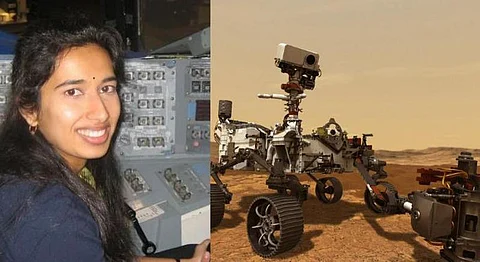
- HOMEGROWN WORLD
- #HGCREATORS
- #HGEXPLORE
- #HGVOICES
- #HGSHOP
- CAREERS
- ABOUT US
- CONTACT US

On 18 February 2021, NASA’s Perseverance rover successfully landed on Mars. “Touchdown confirmed,” announced Indian-American Swati Mohan, who was the “eyes and ears” of the mission. Sitting in the front row of the Jet Propulsion Laboratory, as the Guidance, Navigation, and Controls (GN&C) Operations Lead, she was the first to announce the successful mission to those in the lab as well as the world.
After having emigrated from India at the age of one, she completed her BS at Cornell University in Mechanical & Aerospace Engineering, and her MS and PhD at MIT in Aeronautics/Astronautics. She has been a part of the Perseverance Rover Mission since the project first began in 2013. Apart from that, she has also worked on multiple missions for NASA like Cassini (mission to Saturn) and GRAIL (a pair of formation flown spacecraft to the Moon).
In an interview with USA Today, Mohan explained, “I’ve been on Perseverance longer than I’ve been at any school. I’ve been on Perseverance longer than my younger daughter is alive. It’s just taken up such a large portion of my life for so long.”
Where It All Started
As children, we are all fascinated by what we watch in the movies or the television, claiming to grow up to be either doctors, actors, police officers or astronauts – basically anything that captures our young impressionable minds. Few of us follow through on those dreams, however. For Swati Mohan, her love for space exploration traces its origins to Star Trek.
For NASA’s QnA, Mohan answers on how her love for space and science began: “I remember watching my first episode of Star Trek at the age of 9 and seeing the beautiful depictions of the new regions of the universe that they were exploring. I remember thinking, “I want to do that. I want to find new and beautiful places in the universe.” The vastness of space holds so much knowledge that we have only begun to learn.”
On Her Role During Perseverance Rover Mission
Now, as an adult, she was one of the most important faces of the successful mission. “I am the Mars 2020 Guidance, Navigation, and Controls (GN&C) Operations Lead. The GN&C subsystem is the “eyes and ears” of the spacecraft. During the cruise phase heading toward Mars, our job is to figure out how we are oriented, make sure the spacecraft is pointed correctly in space (solar arrays to the sun, antenna to Earth), and manoeuvre the spacecraft to get it where we want to go. During entry, descent, and landing on Mars, the GN&C determines the position of the spacecraft and commands the manoeuvres it to help it land safely,” she answers on NASA’s QnA.
She further goes on to explain, “As Operations Lead, I am the primary point of communication between the GN&C subsystem and the rest of the project. I am responsible for the training of the GN&C team, scheduling the mission control staffing for GN&C, as well as the policies/procedures the GN&C uses in the mission control room.”
A New Diverse Future
It wasn’t only Swati Mohan who lent the mission a different look. CNN also reported that the mission was diverse in nature and a testament to the changing dynamics of space exploration, where white men are no longer the face of the future.
They wrote, “the Perseverance rover mission was diverse by a number of measures: race, gender, and sexuality. That the team behind the historic spacecraft included folks like landing lead Allen Chen, and engineers such as Moogega Cooper, Cj Giovingo, and Gregorio Villar, shows it was representative of the nation’s demographics.”
Further adding, “That array of names and faces is a sign of the progress NASA has made since it was founded in 1958.” This is special in the light of the fact that the agency has had a history of over-selecting White men until 1978 and viewing them as the face of space exploration program despite the contribution of multiple women and people of colour over the years.
“NASA’s workforce now looks much more like the nation” says CNN, of the more than 17,000 people who work for NASA, “72% are White, 12% are Black, 8% are Asian American or Pacific Islander, 7% are Hispanic or Latino, 1% are American Indian or Alaska Native and less than 1% are more than one race,” according to agency data.
If you enjoyed reading this article, we suggest you also read :
